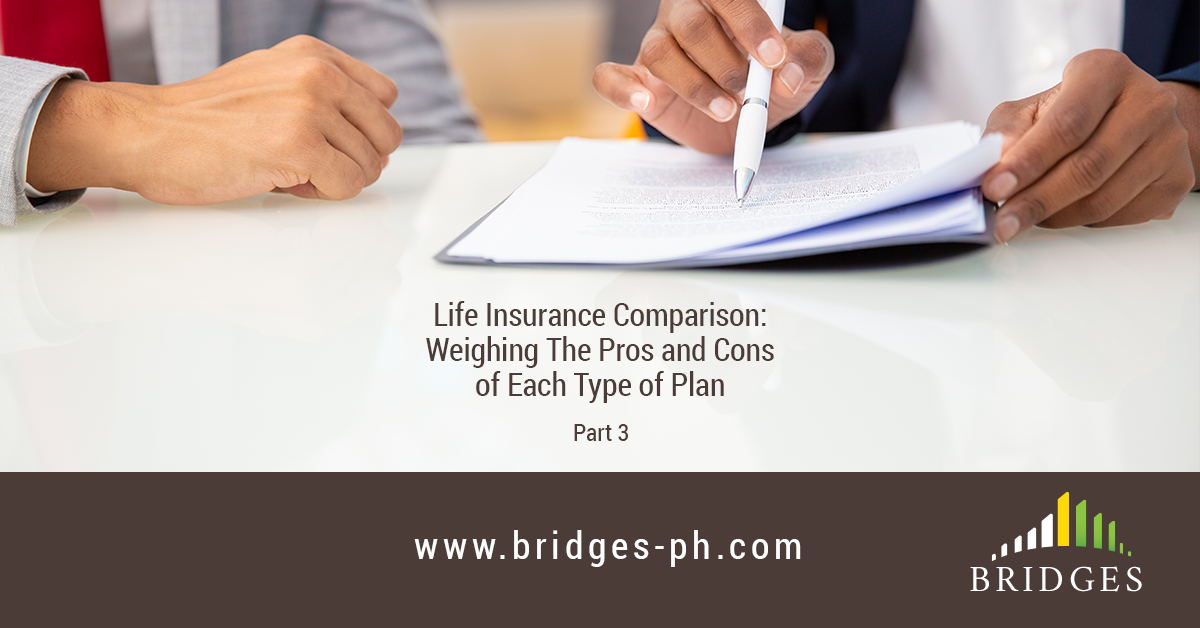
There are different types of life insurance plans available to satisfy different needs, as we’ve discussed in previous entries of this blog series. Each one has its own pros and cons that you should consider before purchasing. And now that you have a clearer picture of what benefits and features are included, it’s easier to compare different plans with each other and find which one works best for you.
For this entry, we’re taking a look at term life insurance:
What is term life insurance?
Term life insurance or term insurance is a type of life insurance that provides you coverage for a specified period of time. The death benefit is paid to your beneficiaries if you die within the specified time frame and while the plan is active or in force. But if the plan expires before your death, there is no payout. You can renew your plan upon its expiry or upgrade it to a different type of plan, though premiums will be recalculated based on your age.
What are its benefits and features?
Usually described as the most basic type of life insurance, term insurance only has one major benefit – the guaranteed death benefit.
There’s a common misconception that you can earn a passive income from term insurance. That’s not true. It actually doesn’t have a savings component, nor does it have living benefits. This means that you can’t use it as a money-generating instrument; you only buy term insurance for the death benefit, nothing else.
Speaking of the death benefit, the amount to be paid out depends on your plan. To use a real product as an example, Sun Life’s 5-year renewable and convertible term plan, SUN Safer Life, has a death benefit that is equivalent to 200% of your plan’s face amount. This is unique to this specific plan, and not all plans include this same benefit.
What’s common among most term insurance plans, however, is that premiums are not leveled. They have an annual or a five-year renewable term, which increases your premium every year or every five years respectively. In case you’re wondering why that is, it’s because the older you get, the higher the chance of death. And the higher the chance of death, the more risk the insurer takes on for covering you.
When it comes to the paying period, term insurance is, of course, shorter compared to other types due to it expiring earlier. To go back to the previous example, the Sun Safer Life plan only covers you up to 75 years old.
Almost all plans give you 31 days of grace period in case you missed your payment. If you fail to pay within that period and your plan lapses, you usually have a three-year reinstatement period where you can get your coverage back, provided that you pay all your missed premiums with added interest.
Because term insurance plans don’t come with cash benefits, they don’t come with non-forfeiture options. They also don’t include hospital confinement benefits. You can, however, add riders to your plan, albeit only a limited number are available. These can include total disability and accidental death and dismemberment benefits.
Banks also accept term insurance as mortgage redemption insurance (MRI) if you’re taking out a loan. MRI, in case you didn’t know, is life insurance that covers the outstanding balance of your loan if ever something were to happen to you during the paying period. It allows the bank to collect a portion or sometimes the entire claim of your life insurance.
Lastly, the contestability period for term insurance is two years, the same as other types of life insurance plans.
Who is it for?
Out of all the different types of life insurance, term insurance is the most straightforward and affordable. Price of premiums are even lower the younger and healthier you are. This makes it the perfect choice for newlyweds, who have yet to or are just starting a family.
It affords you some flexibility in how you’ll want to work out your finances with your spouse. You’ll be dealing with a lot of new expenses, from buying a home to planning your kids’ education, and the last thing you’ll probably want is to pay insurance premiums that don’t fit your budget.
In case coverage is not enough, it’s easy to buy more until you feel that it’s sufficient. It’s not that big of a commitment versus that of other types of insurance where you’re tied down to years-long payment periods. Here, you pay and you enjoy coverage. Retirement expert Tom Hegna said that term life insurance is cheap for a reason: you should buy a lot of it.
You also need not worry about it not having money-generating components, since you can always have your investments separate from your insurance plans.
If you ever one day feel like you need more benefits or your coverage is not enough, you can simply supplement your plan with another; or you can convert your existing one to something new. The Sun Safer Life plan, which we previously mentioned, can be converted to another product, one with living benefits, for instance, till your 65th birthday.
Still confused about what life insurance to get? Don’t hesitate to consult a professional. Our office is open to discussing your personal needs and finding the best plan to suit them.
Also, don’t forget to check back next week for a new entry to this series, where we’ll tackle another type of life insurance.
linkiNG you to opportunities,

photo from www.freepik.com
READ MORE:
- Life Insurance Comparison: Weighing The Pros and Cons of Each Type of Plan – Part 1
- Life Insurance Comparison: Weighing The Pros and Cons of Each Type of Plan – Part 2
- Health Insurance Options: Finding The Perfect Plan For Your Needs – Part 1
- Growing Together: Monetary Incentives To Engage Your Team
- How To Effectively Manage Your Finances During Marriage - Part 1
- Staying Ahead of Life and Death Stakes During the Pandemic – Part 1
- Life Insurance: Preparing for the Inevitable
- How You Can Secure Your Family’s Future From Life’s Uncertainties
- Preparing For Marriage: Priorities, Discipline, and Expectations


